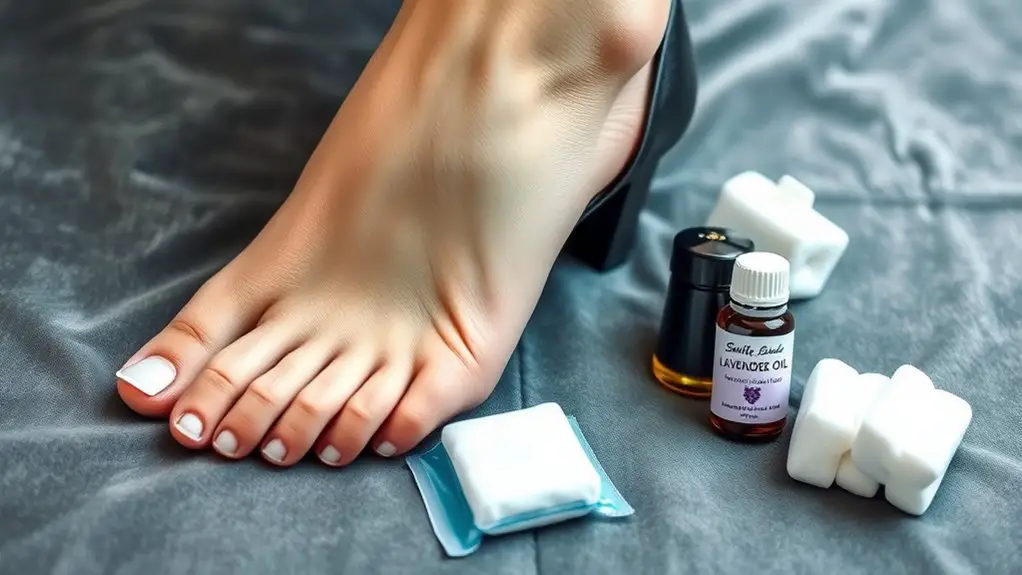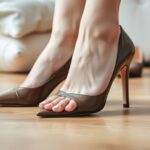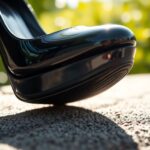To treat blisters from high heels, start by applying a cold compress to reduce pain and inflammation. Clean the area gently with mild soap and water, then dry it before using a sterile bandage. Natural remedies like aloe vera gel can soothe and promote healing. Avoid popping blisters to maintain a protective barrier against infection. By following these steps, you can ease discomfort and recover faster. Continue to explore more effective strategies for managing blister symptoms.
Understanding the Causes of Blisters

When you wear high heels, the friction and pressure they create can lead to the formation of blisters on your feet. Friction causes the outer layer of skin to rub against the shoe material, resulting in irritation and damage. This process is exacerbated by moisture factors, such as sweat, which can soften the skin and make it more susceptible to injury. As you walk, the repetitive motion increases the friction, leading to the formation of fluid-filled pockets beneath the skin’s surface.
In addition, the design of high heels often forces the foot into unnatural positions, intensifying pressure on specific areas. These combined factors—friction and moisture—play a critical role in blister development. Understanding these causes is essential for recognizing the risks associated with high heels and the physiological responses of your feet. By being aware, you can better manage and treat the consequences of wearing such footwear.
Prevention Tips to Avoid Blisters
To minimize the risk of blisters while wearing high heels, implementing preventive measures is essential. First, focus on proper shoe selection. Choose heels that fit well, providing adequate support and cushioning. Guarantee there’s enough room in the toe box to prevent friction. Additionally, materials that offer breathability can help reduce moisture buildup, which is another factor contributing to blisters.
Moisture management is vital in blister prevention. Consider using moisture-wicking socks or foot powders to keep your feet dry. If you anticipate prolonged wear, applying blister prevention products, such as gel pads or moleskin, can provide extra protection.
Before wearing your heels, break them in gradually. This allows your feet to adjust to the shoe’s shape and reduces the likelihood of friction. By utilizing these strategies, you’ll enhance comfort and considerably lower the risk of developing blisters while enjoying your high heels.
Immediate Relief for Blister Pain
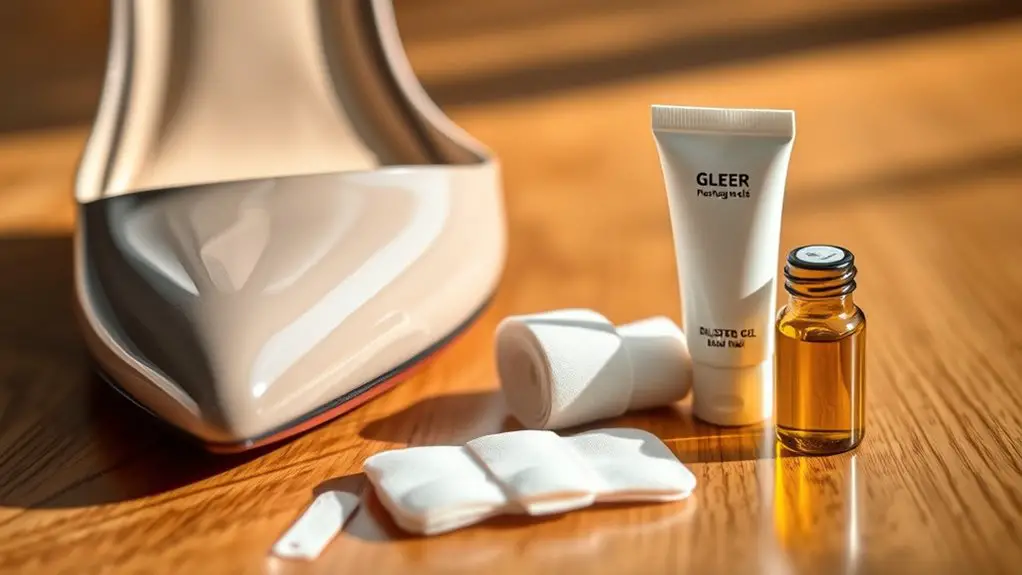
One effective way to address blister pain immediately is by using a cold compress. Applying a cold compress to the affected area can greatly reduce inflammation and provide quick pain relief. Simply wrap ice in a cloth or use a cold gel pack, and place it on the blister for 10 to 15 minutes. This method constricts blood vessels, which decreases swelling and numbs the pain.
If a cold compress isn’t available, you can also use a clean, damp cloth with cold water to achieve similar results. Avoid direct contact with ice, as it can cause frostbite.
In addition to cold compresses, over-the-counter pain relievers like ibuprofen or acetaminophen can further alleviate discomfort. Remember to follow the recommended dosages for these medications. Implementing these strategies can help you manage blister pain effectively while you seek longer-term solutions.
Natural Remedies for Soothing Blisters
Natural remedies can provide effective relief for blisters caused by high heels. Applying aloe vera can soothe irritation and promote healing, while tea tree oil offers antibacterial properties that may prevent infection. Using these ingredients can facilitate a quicker recovery and enhance comfort during the healing process.
Aloe Vera Application
While high heels can elevate your style, they often come with the downside of painful blisters. One effective natural remedy is aloe vera. The aloe vera benefits include its anti-inflammatory, soothing, and moisturizing properties, which can greatly reduce discomfort. To use it, apply a thin layer of aloe vera gel directly onto the blistered area. This gel promotes healing by providing a protective barrier and preventing infection. You should reapply the gel several times a day, especially after washing the area. Additionally, the cooling sensation of aloe vera can alleviate pain and irritation, allowing you to manage your blisters more effectively. Incorporating aloe vera into your blister treatment routine can enhance recovery and comfort greatly.
Tea Tree Oil
Tea tree oil, known for its potent antiseptic properties, serves as an effective remedy for soothing blisters caused by high heels. This natural solution offers several tea tree benefits that can aid in blister treatment, promoting faster healing and reducing inflammation. When applying tea tree oil, follow these steps for ideal results:
- Dilute the oil with a carrier oil to prevent skin irritation.
- Apply the mixture gently to the blister and surrounding area.
- Cover it with a bandage to protect the blister from further friction.
- Repeat daily until the blister heals completely.
How to Properly Care for Blisters
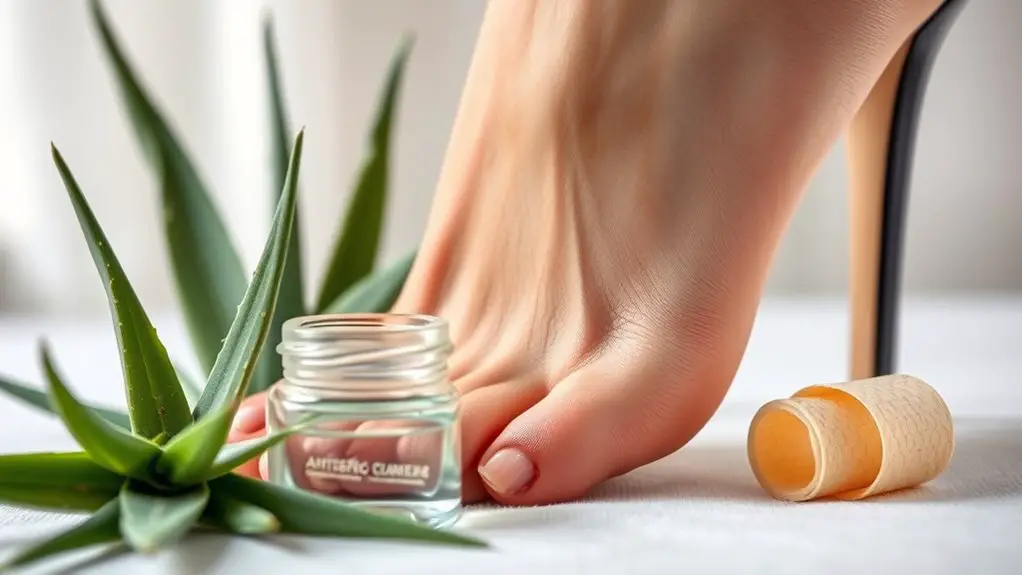
Caring for blisters effectively is essential to guarantee proper healing and prevent infection. Start by cleaning the area gently with mild soap and water; this helps to remove dirt and bacteria. Pat the blister dry with a clean towel. If the blister is intact, avoid popping it, as the skin provides a natural barrier against infection. For blister care, apply a sterile bandage to protect it from further friction. If the blister has burst, apply an antiseptic ointment and cover it with a non-stick bandage. Change the bandage daily or whenever it becomes wet or dirty to maintain a clean environment, promoting the healing process. Monitor the blister for signs of infection, such as increased redness, swelling, or pus. Keeping the area clean and protected will greatly aid in your recovery, minimizing discomfort and speeding up the healing process.
When to Seek Medical Attention
Knowing when to seek medical attention for blisters is essential, especially if you notice signs of complications. While most blisters from high heels heal on their own, certain symptoms necessitate a visit to a healthcare professional.
Recognizing when to seek medical attention for blisters is crucial, especially if complications arise.
Consider seeking help if you experience:
- Signs of infection: Increased redness, warmth, or pus around the blister.
- Persistent pain: Pain that doesn’t ease with over-the-counter treatments.
- Fever: A body temperature above 100.4°F (38°C) could indicate a systemic infection.
- Large or deep blisters: Blisters that are particularly large or appear to penetrate deeper layers of skin.
Prompt attention can prevent further complications and guarantee proper healing. Trust your instincts; if something feels off, it’s better to consult a healthcare provider than to risk worsening your condition.
Frequently Asked Questions
Can Blisters From High Heels Lead to Infections?
Yes, blisters can lead to infections if not properly treated. You should monitor for infection symptoms like redness, swelling, or pus. Practicing blister prevention techniques can markedly reduce the risk of serious complications.
Are Certain High Heel Brands More Blister-Prone Than Others?
Oh, the glamorous world of high heels! While brand comparisons can reveal differences, it often boils down to heel materials. Some brands use softer materials, reducing blister risks, while others seem intent on torturing your feet.
How Long Do Blisters From High Heels Typically Take to Heal?
Blisters from high heels typically take one to two weeks for complete healing. Proper high heel care, including keeping the area clean and protected, can accelerate blister healing and prevent further irritation or infection.
Can I Wear Socks With High Heels to Prevent Blisters?
Imagine your feet wrapped in a cozy layer; wearing socks with high heels can prevent blisters. However, not all sock styles work with every heel type, so choose wisely for comfort and style.
What Is the Best Way to Break in New High Heels?
To break in new high heels effectively, consider heel stretching techniques and using comfort insoles. These methods can alleviate pressure and enhance fit, ensuring a more comfortable experience while wearing your new footwear.

